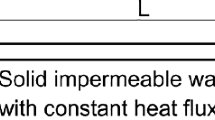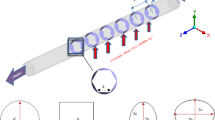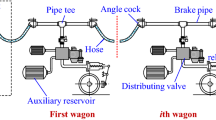Abstract
Evacuated tube transportation is an important development direction for the high-speed transportation technology of the future. However, a train running at supersonic speed in a closed tube can create an unstable aerothermal phenomenon, causing the temperature to rise sharply inside the tube and endangering the safe operation of trains and equipment. The blockage ratio is one of the key factors affecting the aerodynamic characteristics in the tube. In this paper, a 2D axisymmetric model and Delayed Detached Eddy Simulation (DDES) based on the Shear Stress Transport (SST) k-ω turbulence model are used to study the aerothermal environment in the tube. The calculation method used in this paper was verified by a wind tunnel experiment. The aerothermal phenomenon and distribution of the flow field in the tube with different blockage ratios were compared and analysed. The results show that the aerothermal environment is significantly affected by the blockage ratio. A choking limit formed in the flow field will aggravate the aerodynamic phenomenon as the blockage ratio increases, which further deteriorates the aerothermal environment of the tube. Moreover, the existence of the choking limit, shock wave, and Mach disk make the flow field in the tube more complicated.
Similar content being viewed by others
References
Raghunathan R.S., Kim H.D., Setoguchi T., Aerodynamics of high-speed railway train. Progress in Aerospace sciences, 2002, 38(6–7): 469–514.
Schetz J.A., Aerodynamics of high-speed trains. Annual Review of fluid mechanics, 2001, 33(1): 371–414.
Oh J.S., Kang T., Ham S., Lee K.S., Jang Y.J., Ryou H.S., Ryu J., Numerical analysis of aerodynamic characteristics of hyperloop system. Energies, 2019, 12(3): 518.
Li Q. L., Jia W. G., Dong C. G., & Duan R. X. Numerical Research of Thermal-pressure Coupling Effect on Blockage Ratio in the Evacuated Tude Transportation System. In Key Engineering Materials, 2013, 561: 454–459.
Liu J., Zhang J., Zhang W., Analysis of aerodynamic characteristics of high-speed trains in the evacuated tube. Journal of Mechanical Engineering, 2013, 49(22): 137–143.
Janić M., Future advanced long-haul Evacuated Tube Transport (EET) system operated by TransRapid Maglev (TRM): a multidimensional examination of performance. Transportation Planning and Technology, 2019, 42(2): 130–151.
Oster D., Kumada M., Zhang Y.P., Evacuated tube transport technologies (ET3) tm: a maximum value global transportation network for passengers and cargo. Journal of Modern Transportation, 2011, 19(1): 42–50.
Gillani S.A., Panikulam V.P., Sadasivan S., Zhang Y.P., CFD analysis of aerodynamic drag effects on vacuum tube trains. Journal of Applied Fluid Mechanics, 2019, 12(1): 303–309.
Quinn R.D., Gong L., A method for calculating transient surface temperatures and surface heating rates for high-speed aircraft. 2000, NASA/TP-2000–209034.
Ma J., Zhou D., Zhao L., Zhang Y., Zhao Y., The approach to calculate the aerodynamic drag of maglev train in the evacuated tube. Journal of Modern Transportation, 2013, 21(3): 200–208.
Niu J., Sui Y., Yu Q., Cao X., Yuan Y., Numerical study on the impact of Mach number on the coupling effect of aerodynamic heating and aerodynamic pressure caused by a tube train. Journal of Wind Engineering and Industrial Aerodynamics, 2019, 190: 100–111.
Chen X., Zhao L., Ma J., Liu Y., Aerodynamic simulation of evacuated tube maglev trains with different streamlined designs. Journal of Modern Transportation, 2012, 20(2): 115–120.
Bibin S., Mukherjea S.K., Numerical investigation of aerodynamic drag on vacuum tube high speed train. In: ASME 2013 International Mechanical Engineering Congress and Exposition. American Society of Mechanical Engineers, 2013. Paper No.: IMECE2013–65703, V013T14A048.
Kwon H.B., Kang B.B., Kim, B.Y., Lee D.H., Jung H.J., Parametric study on the aerodynamic drag of ultra high-speed train in evacuated tube-part 1. J. Kor. Soc. Railway, 2010, 13 (1): 44–50
Bao S., Wang B., Zhang Y., Deng Z., Preliminary study of aerodynamic characteristics of high temperature superconducting maglev-evacuated tube transport system. DEStech Transactions on Engineering and Technology Research, 2017, pp. 236–249.
Bhadauriya S., Kapadia H., Dalal A., & Sarkar S., Effect of channel confinement on wake dynamics and forced convective heat transfer past a blunt headed cylinder. International Journal of Thermal Sciences, 2018, 124: 467–476.
Ozalp A.A., Dincer I., Hydrodynamic-thermal boundary layer development and mass transfer characteristics of a circular cylinder in confined flow. International Journal of Thermal Sciences, 2010, 49(9): 1799–1812.
Mi B., Zhan H., Zhu, J., Simulation of aerodynamic drag of high-speed train in evacuated tube transportation. Chinese Journal of Vacuum Science and Technology, 2013, 33(9): 877–882.
Zhang Y., Numerical simulation and analysis of aerodynamic drag on a subsonic train in evacuated tube transportation. Journal of Modern Transportation, 2012, 20(1): 44–48.
Oh J. S., Kang T., Ham S., Lee K. S., Jang Y. J., Ryou, H. S., Ryu, J., Numerical analysis of aerodynamic characteristics of hyperloop system. Energies, 2019, 12(3): 518.
Zhou P., Zhang J., Li T., Effects of blocking ratio and Mach number on aerodynamic characteristics of the evacuated tube train. International Journal of Rail Transportation, 2020, 8(1): 27–44.
Zhou Y., Jia W., Wang K., Liu H., Li Q., Analysis of energy consumption in the ETT system based on blocking ratio. Chinese Journal of Vacuum Science and Technology, 2019, 37(2): 131–136.
Opgenoord M.M., Caplan P.C., Aerodynamic design of the Hyperloop concept. AIAA Journal, 2018, 56(11): 4261–4270.
Braun J., Sousa J., Pekardan C., Aerodynamic design and analysis of the hyperloop. AIAA Journal, 2017, 4053–4060.
Kim T.K., Kim K.H., Kwon H.B., Aerodynamic characteristics of a tube train. Journal of wind engineering and industrial aerodynamics, 2011, 99(12): 1187–1196.
Baron A., Mossi M., Sibilla S., The alleviation of the aerodynamic drag and wave effects of high-speed trains in very long tunnels. Journal of Wind Engineering and Industrial Aerodynamics, 2011, 89(5): 365–401.
Dong C., The influence of blockage ratio on aerodynamic heating and heat transfer of the evacuated tube transportation system. Qingdao University of Science and Technology, Qingdao, China, 2013. (in Chinese)
Liu J., Zhang J., Zhang W., Impacts of pressure, blockage ratio and speed on aerodynamic drag force of high-speed trains. Chinese Journal of Vacuum Science and Technology, 2014, 34(1): 10–15.
Arun K.M., Tiwari S., Mani A., Three-dimensional numerical investigations on rectangular cross-section ejector. International Journal of Thermal Sciences, 2017, 122: 257–265.
Qin Y., Qu Q., Liu P., Tian Y., Lu Z., DDES study of the aerodynamic forces and flow physics of a delta wing in static ground effect. Aerospace Science and Technology, 2015, 43: 423–436.
Li T., Hemida H., Zhang J., Rashidi M., Flynn, D., Comparisons of shear stress transport and detached eddy simulations of the flow around trains. Journal of Fluids Engineering, 2018, 140(11): 111108.
Tao Y., Li Y., Zhang Z., Zhao Z., Liu Z., Transonic wing stall of a blended flying wing common research model based on DDES method. Chinese Journal of Aeronautics, 2016, 29(6): 1506–1516.
Anderson Jr J.D., Fundamentals of aerodynamics. International Edition, McGraw Hill Inc, USA, 2010.
Niu J.Q., Zhou D., Liang X.F., Liu S., Liu T.H., Numerical simulation of the Reynolds number effect on the aerodynamic pressure in tunnels. Journal of Wind Engineering and Industrial Aerodynamics, 2018, 173: 187–198.
Xiang X.T., Xue L.P., Tunnel hood effects on high speed train-tunnel compression wave. Journal of Hydrodynamics, Ser. B, 2010, 22(5): 940–947.
Chu C.R., Chien S.Y., Wang C.Y., Wu T.R., Numerical simulation of two trains intersecting in a tunnel. Tunnelling and Underground Space Technology, 2014, 42: 161–174.
Stine H.A., Wanlass K. Theoretical and experimental investigation of aerodynamic-heating, and isothermal heat-transfer parameters on a hemispherical nose with laminar boundary layer at supersonic Mach numbers. Technical Report Archive and Image Library, 1954.
Kantrowitz A., Donaldson C.D., Preliminary investigation of supersonic diffusers. In National Advisory Committee for Aeronautics, 1945, ACR NO. L5D20.
Sousa J., Paniagua G., Entropy minimization design approach of supersonic internal passages. Entropy, 2015, 17(8): 5593–5610.
Ric B., Wei S., Fluid dynamics and aerothermodynamics. Beijing Institute of Technology Press, Beijing, China, 2016.
Cao D., He G., Qin F., Wei X., Shi L., Liu B., Huang Z., LES study on flow features of the supersonic mixing layer affected by shock waves. International Communications in Heat and Mass Transfer, 2017, 85: 114–123.
Alam M.A., Matsuo S., Setoguchi T., Effect of non-equilibrium homogeneous condensation on the self-induced flow oscillation of supersonic impinging jets. International Journal of Thermal Sciences, 2010, 49(11): 2078–2092.
Ono N., Yamamoto M., Koike K., Detection of shock structure around Mach disk in axisymmetric plasma jet. Vacuum, 2014, 110: 149–153.
Zhang Y., Wang, B., Zhang H., Xue S., Mixing enhancement of compressible planar mixing layer impinged by oblique shock waves. Journal of Propulsion and Power, 2014, 31(1): 156–169.
Kim D., Lee J., Influence of shock structure on heat transfer characteristics in supersonic under-expanded impinging jets. International Journal of Thermal Sciences, 2019, 141: 62–71.
Cao W., Zhou H., Existence of shocklets in a two-dimensional supersonic mixing layer and its influence on the flow structure. Science in China, Series A, 2001, 44(9): 1182–1188.
Acknowledgement
This work was supported by the National Natural Science Foundation of China (51805453 and 51978575), the Fundamental Research Funds for the Central Universities (2682018CX14), Project funded by China Postdoctoral Science Foundation (2019M663551) and Doctoral Innovation Fund Program of Southwest Jiaotong University.
Author information
Authors and Affiliations
Corresponding author
Rights and permissions
About this article
Cite this article
Sui, Y., Niu, J., Yuan, Y. et al. An Aerothermal Study of Influence of Blockage Ratio on a Supersonic Tube Train System. J. Therm. Sci. 31, 529–540 (2022). https://doi.org/10.1007/s11630-020-1281-7
Received:
Published:
Issue Date:
DOI: https://doi.org/10.1007/s11630-020-1281-7




